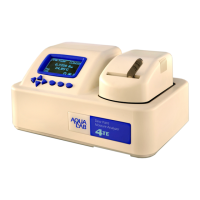3 WATER ACTIVITY THEORY AquaLab
and the system to come to internal equilibrium. It is important to
remember the restriction of the definition of water activity to equi-
librium.
Temperature Effects
Temperature plays a critical role in water activity determination.
Most critical is the measurement of the difference between sample
and dew point temperature. If this temperature difference were in
error by 1
◦
C, an error of up to 0.06 a
w
could result. In order
for water activity measurements to be accurate to 0.001, tempera-
ture difference measurements need to be accurate to 0.017
◦
C. The
AquaLab infrared thermometer measures the difference in temper-
ature between the sample and the block. It is carefully calibrated
to minimize temperature errors, but achieving 0.017
◦
C accuracy is
difficult when temperature differences are large. Best accuracy is
therefore obtained when the sample is near chamber temperature.
Another effect of temperature on water activity occurs when sam-
ples are near saturation. A sample that is close to 1.0 a
w
and is only
slightly warmer than the sensor block will condense water within the
block. This will cause errors in the measurement, and in subsequent
measurements until the condensation disappears. A sample at 0.75
a
w
needs to be approximately 4
◦
C above the chamber temperature
to cause condensation. The AquaLab warns the user if a sample is
more than 4
◦
C above the chamber temperature, but for high water
activity samples the operator needs to be aware that condensation
can occur if a sample that is warmer than the block is put in the
AquaLab.
3.3 Water Potential
Some additional information may be useful for understanding what
water activity is and why it is such a useful measure of moisture
status in products. Water activity is closely related to a thermody-
namic property called the water potential, or chemical potential (µ)
of water, which is the change in Gibbs free energy (∆G) when water
concentration changes. Equilibrium occurs in a system when (µ) is
10

